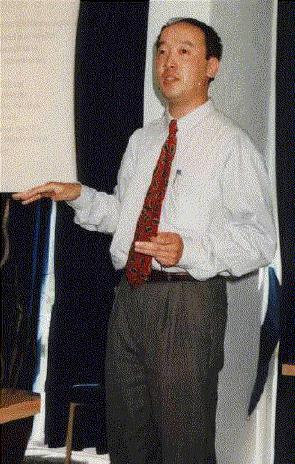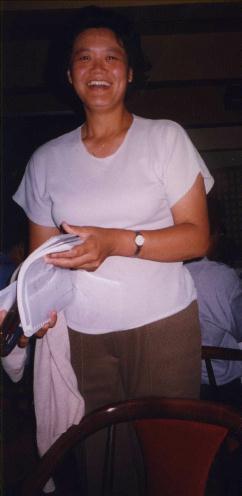Kiwi Combustion Dudes: Page Two
 X. Dong Chen
obtained his Bachelor of Engineering Degree in Engineering Thermophysics from
the Department of Engineering Mechanics, Tsinghua University, Beijing, China in
1987. He worked briefly in the Combustion Laboratory at the Chinese Academy of
Sciences in Beijing before coming to NZ to work on the spontaneous combustion of
coal for his PhD. In early 1991, he was awarded a PhD in Chemical and Process
Engineering, University of Canterbury, Christchurch, New Zealand. Dong then
started working as a Research Engineer at New Zealand Dairy Research
Institute in Palmerston North and was subsequently promoted to Senior
Research Engineer after 18 months. Dong made a significant contribution in
the understanding of milk powder agglomeration (fundamentals and
industrial operations) and in improving the powder functionality for the
NZ dairy industry. In September 1993, Dong joined the Department
of Chemical and Materials Engineering at The University of Auckland as a
Lecturer. Within a year he was soon promoted to Senior Lecturer and in
February 1998, he was promoted to Associate Professor.
X. Dong Chen
obtained his Bachelor of Engineering Degree in Engineering Thermophysics from
the Department of Engineering Mechanics, Tsinghua University, Beijing, China in
1987. He worked briefly in the Combustion Laboratory at the Chinese Academy of
Sciences in Beijing before coming to NZ to work on the spontaneous combustion of
coal for his PhD. In early 1991, he was awarded a PhD in Chemical and Process
Engineering, University of Canterbury, Christchurch, New Zealand. Dong then
started working as a Research Engineer at New Zealand Dairy Research
Institute in Palmerston North and was subsequently promoted to Senior
Research Engineer after 18 months. Dong made a significant contribution in
the understanding of milk powder agglomeration (fundamentals and
industrial operations) and in improving the powder functionality for the
NZ dairy industry. In September 1993, Dong joined the Department
of Chemical and Materials Engineering at The University of Auckland as a
Lecturer. Within a year he was soon promoted to Senior Lecturer and in
February 1998, he was promoted to Associate Professor.
Dong has a variety of interests in research covering heat, mass transfer
and chemical kinetics in food process engineering, separation processes
including drying, membrane separation, oil fractionation and aqueous
two-phase partitioning, fermentation processes, self-heating processes
and fire protection engineering etc. Dong has some
200 publications including 80 journal papers, 80 conference papers and over 50
technical reports to private sponsors. Dong is the leader of the
Food and Biochemical Engineering Cluster, one of the 12 Research Clusters
in the Auckland School of Engineering. He is also the Academic Co-ordinator
of the Biotechnology Teaching Program at the School, and the Fermentation
Laboratories. He is the current President of Food Engineering Association
(NZ). He was the recipient of 1995 Merit Award for Excellence in Teaching,
School of Engineering.
Dong has close working relationships with NZ industries and has carried out
significant amounts of applied process engineering research. He has also
acted as a consultant on many occasions for various companies. His strength
has been to provide new and simple ideas to complex problems and also
apply fundamental theories in an innovative fashion.
Source: Citation for the Shedden Uhde Medal in 1999
for "...practical services to the profession
and practice of chemical engineering in Australia/New Zealand."
Dong was elected a Fellow of the Royal Society of New
Zealand in 2001 in recognition of his work solving many practical engineering
problems for the New Zealand food processing industry. By identifying the key
elements of these problems and modelling them mathematically Dong Chen has been
ble to suggest improvements in the processes, increasing efficiency and
cutting costs.
He has also developed a new and much cheaper test for determining the
mechanism of spontaneous combustion in milk powders and sawdust.
Source: A news item on the
Department of Chemical
& Materials Engineering web page at the University of Auckland.
Dr. X. Dong Chen giving a presentation at the
Combustion Meeting in Honour of Professor
B.F. Gray, 11-12 February 1999, Mollymook, NSW, Australia.
Photograph by Mark Nelson.
Human fireball myth up in flames. An article from
The Dominion (Wednesday November 4 1998)
with a good photograph of Dong.
 Ying (Rose) Gong
graduated Master of Engineering fron China and came to to New Zealand
in the early nineties. She enrolled in a Doctor of Philosophy degree in
(Applied) Mathematics while simultaneously working in in a Public Good Science
funded program in car emissions in 1993. Her work involved a mix of
engineering and mathematical approaches to the problem of spontaneous ignition
in wet coals. The PhD research involved the investigation of the effect of
water on the ignition characteristics of brown coals, which both inhibits and
enhances the likelihood of spontaneous ignition. This reaearch was supervised
by Professor Graeme Wake and Dr John Burnell of Industrial Research Ltd and
was partly funded under a Marsden Fund program. The model and its
analysis has also been published in the International Journal:
Combustion Theory and Modelling.
Ying (Rose) Gong
graduated Master of Engineering fron China and came to to New Zealand
in the early nineties. She enrolled in a Doctor of Philosophy degree in
(Applied) Mathematics while simultaneously working in in a Public Good Science
funded program in car emissions in 1993. Her work involved a mix of
engineering and mathematical approaches to the problem of spontaneous ignition
in wet coals. The PhD research involved the investigation of the effect of
water on the ignition characteristics of brown coals, which both inhibits and
enhances the likelihood of spontaneous ignition. This reaearch was supervised
by Professor Graeme Wake and Dr John Burnell of Industrial Research Ltd and
was partly funded under a Marsden Fund program. The model and its
analysis has also been published in the International Journal:
Combustion Theory and Modelling.
Using the heat and mass balances it is possible to analyse the onset of
ignition by detecting mathematically the threshold of gross parametric
sensitivity the thermal response. The complex chemistry incorporated in
the model enables the effect of water in both the liquid and vapour phases to
be quantified. In certain parameter ranges it is found that the presence of
liquid water increases the likelihood of spontaneous ignition. This is
experimentally observed in recently mined brown coals during transport.
Precise limits can be derived from this analysis thus establishing
precise criteria to underpin practical procedures in
"decision support".
The analysis uses the modern day parameter path-following methods which detects
computationally the swaps in stability and the onset of oscillatory behaviour,
signaling the likelihood of a thermal event (catastrophe). The research looks
at the two situations: without and with spatial structure. The
latter case shows the presence of a "heat-curtain" which is highly significant
as it occurs as a consequence of the presence of water in the model.
Ying Gong (Rose)
is now working full-time as a Science-leader in Victoria-Link on the work
involved in Car Emissions.
Source: University of Auckland October 2000 Convocation
Booklet, page 82.
Rose Gong at the Combustion Meeting in Honour of Professor
B.F. Gray, 11-12 February 1999, Mollymook, NSW, Australia.
Photograph by Mark Nelson.
<< Return to my start page.
<< Return to my photographic index.
Page Created: 12th April 2000.
Last Updated: 5th January 2001.
 X. Dong Chen
obtained his Bachelor of Engineering Degree in Engineering Thermophysics from
the Department of Engineering Mechanics, Tsinghua University, Beijing, China in
1987. He worked briefly in the Combustion Laboratory at the Chinese Academy of
Sciences in Beijing before coming to NZ to work on the spontaneous combustion of
coal for his PhD. In early 1991, he was awarded a PhD in Chemical and Process
Engineering, University of Canterbury, Christchurch, New Zealand. Dong then
started working as a Research Engineer at New Zealand Dairy Research
Institute in Palmerston North and was subsequently promoted to Senior
Research Engineer after 18 months. Dong made a significant contribution in
the understanding of milk powder agglomeration (fundamentals and
industrial operations) and in improving the powder functionality for the
NZ dairy industry. In September 1993, Dong joined the Department
of Chemical and Materials Engineering at The University of Auckland as a
Lecturer. Within a year he was soon promoted to Senior Lecturer and in
February 1998, he was promoted to Associate Professor.
X. Dong Chen
obtained his Bachelor of Engineering Degree in Engineering Thermophysics from
the Department of Engineering Mechanics, Tsinghua University, Beijing, China in
1987. He worked briefly in the Combustion Laboratory at the Chinese Academy of
Sciences in Beijing before coming to NZ to work on the spontaneous combustion of
coal for his PhD. In early 1991, he was awarded a PhD in Chemical and Process
Engineering, University of Canterbury, Christchurch, New Zealand. Dong then
started working as a Research Engineer at New Zealand Dairy Research
Institute in Palmerston North and was subsequently promoted to Senior
Research Engineer after 18 months. Dong made a significant contribution in
the understanding of milk powder agglomeration (fundamentals and
industrial operations) and in improving the powder functionality for the
NZ dairy industry. In September 1993, Dong joined the Department
of Chemical and Materials Engineering at The University of Auckland as a
Lecturer. Within a year he was soon promoted to Senior Lecturer and in
February 1998, he was promoted to Associate Professor.
